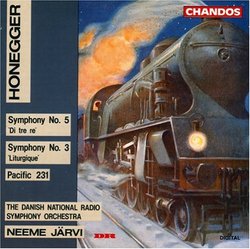"Pacific 231" never sounded so good!
Lee Hartsfeld | Central Ohio, United States | 11/25/2001
(5 out of 5 stars)
"Arthur Honegger may have been the greatest composer of the "Les Six" group. Francis Poulenc was certainly easier to listen to, and he was brilliant in his own right. And Darius Milhaud, an instructor of big-name jazz musicians and Burt Bacharach, had an extraordinary command of counterpoint and a flawless sense of form. But there seems to be something more substantial about Honegger's music, for all its sternness and sometimes turgid texture. His music is hard to warm up to, but, believe me, it is worth the journey.Speaking of journeys (and on the same train of thought), the "Pacific 231" performance contained on this CD is beyond faulting. The recording engineer has refrained from adding any artificial effects to the mix, especially during the chromatically-descending polytonal slow-down near the end--every wonderful, crashing note shines through. I live for this moment when I listen to this piece. I envision a deer on the tracks and frantic cries of "Stop the train!" ("Gunsmoke" marathons on TVLand are to blame, here.)The symphonies, by contrast, are not crowd-pleasers. They are demanding, dissonant, and (often) dark works that unfold with a cold logic offset by melodic genius of the first order and huge helpings of humanity. Such a balance between warmth and austerity might be Honegger's most amazing achievement."
Shamefully Neglected 20th-Century Master
NMdesapio | 09/11/2005
(5 out of 5 stars)
"I dare anyone to listen to the expansive, hauntingly beautiful slow movement of Arthur Honegger's Symphony #3 (subtitled "Liturgique") and not feel that we are dealing with one of the unjustly neglected composers of the last century. Although often grouped with LES SIX (the iconoclastic group of composers in 1920's Paris responsible for breathing a lot of fresh air into music), Honegger had little in common with them. By his own admission he had "no taste for the fairground [or] the music hall", and preferred to write serious-minded orchestral music, chamber music, and oratorios.
Like its predecessor the Symphony #2 for strings and trumpet, the Symphony #3 has strong extra-musical associations, having been composed at the end of World War II when Honegger was absorbed in pessimistic thoughts about humanity's self-destructive tendencies. Each movement bears a Latin inscription from Catholic liturgy. The first movement, "Dies Irae", is appropriately explosive and harsh, full of striking sonorities and Stravinksy-like (eg. SYMPHONY IN 3 MOVEMENTS) in its block-like structures. In the stunning second movement, "De profundis clamavi", the lyric floodgates open as Honegger spins out an inexorable thread of melody through various harmonic changes like changing clouds. The final movement, "Dona nobis pacem", brings back the barbarism of the first (reflecting "the rise of collective stupidity") before dissolving into a final prayer-like Adagio in which the flute, representing the "dove of peace", hovers serenely above the orchestra.
The more slight Symphony #5 ("Di tre re") pales a bit incomparison with #3, though it offers some striking block-like polyharmonies and kinetic energy.
PACIFIC 231, a short tone poem for orchestra written in 1923, shows the younger, brash Honegger. This piece, with its startlingly realistic depictions of a steam locomotive, created a sensation and became emblematic of the Age of Steel.
Of the "French Six", only Francis Poulenc - once the clown of the group and later masterful composer of sacred music and songs - has survived in the repertory. Many listeners will see why I feel that Honegger needs a revival and deserves a more prominent place in the early modern pantheon. His music combines French sensibility with Germanic feel for "message" and personal expression. His symphonies are surely some of the most important in a century that produced few works in that august genre. Honegger's music needs to be heard, and the third symphony is a great place to start."
One of the Best Honegger Discs
Samuel Stephens | TN, USA | 08/11/2007
(5 out of 5 stars)
"I can compare the performances of these two with Plasson's EMI 2-disc set. They are a lot more steady, wieghty, and, to me, more appropriate for Honegger's music.
This "Pacific 231" is far preferable to the one Plasson conducts on that admirable set. If you think Pacific 231 should move more steady, this is what you want. Full recommendation to Honegger lovers."


 Track Listings (7) - Disc #1
Track Listings (7) - Disc #1![Haydn: Symphonies Nos. 40-54 [Box Set]](https://nationalbookswap.com/cd//m/63/7463/6027463.jpg)
